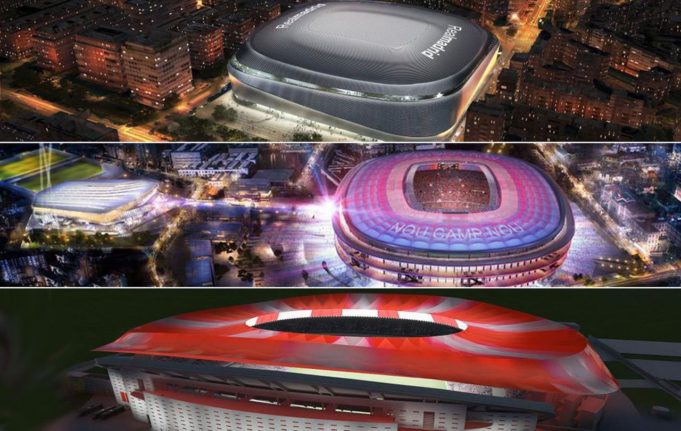Spain’s top three clubs – Real Madrid, Barcelona and Atletico Madrid – are in the midst of major changes and will all soon be playing in comfortable new (or renovated) stadiums. As a result it’s particularly interesting to compare the projects with each other, as Spanish newspaper Marca has done, to see which is the most innovative, which is the most expensive, and what the most interesting features about each of the projects are.
How long until the new stadiums are ready?
Atletico Madrid were the first to state their intention to have a new stadium, and they will move to their new ground at la Peineta next season. Work began back in 2011 and is already well-advanced, and the club intends to allow players and fans to get to know the new ground while work is brought to completion. If everything goes well, the new ground will be ready by the start of the 2017/18 season.
Barcelona, meanwhile, are aiming to increase the Camp Nou’s capacity to 105,000. However, work on the Catalan club’s stadium hasn’t yet started as they don’t have the city’s permission to do so. Work isn’t likely to be completed until the 2020/21 season.

In Real Madrid’s case, the European champions only officially presented their project a few days ago. If everything goes well, modifications to the Santiago Bernabeu will begin next summer, as soon as the season has finished. Like Barcelona, they are also aiming to inaugurate the redeveloped stadium by the end of the 2020/21 season.
How many people will the new stadiums hold?
All three Spanish sides are undertaking new stadium projects to create a better match day experience for fans. Atletico Madrid are leaving the Vicente Calderon after 50 years for a bigger ground, increasing capacity from 55,000 to 68,000.
While Barcelona are staying at the Camp Nou, they are redeveloping the ground in order to increase its total capacity to 105,000 people.
However, there will be no change to the capacity of the Santiago Bernabeu: 81,044 people will be able to get in to watch Real Madrid as they do now.

How much will each stadium cost?
The amount of money required to complete the works is an aspect that shouldn’t be underestimated when a stadium is redeveloped or a new stadium constructed. The most expensive project is certainly Barcelona’s: as well as increasing the capacity, the Catalan club are planning to redevelop the Palau Blaugrana to include several independent, multifunctional sports facilities. Overall, it will cost around €600 million.
The new Santiago Bernabeu, meanwhile, will need around €400 million of investment, while los Colchoneros’ move to La Peineta will cost them a total of around €220 million.
What are the features of each new stadium?
Whenever a new stadium project is presented, there is always a particular interest in seeing what it will look like.
Atletico Madrid’s stadium will feature a roof constructed in the shape of a wave, which will cover 96% of the seats. Thanks to their recent agreement with new sponsor Philips Lighting, the stadium will be equipped with lighting technology to illuminate it in the club colours of red and white and put on displays featuring images from the club’s history.
The new Camp Nou, meanwhile, will be fully covered by a 47,000m2 roof. It will have an open facade, and will be formed of three tiers with pitched eaves. There will also be a skywalk where every spectator can experience a 360 degree view looking both inside and outside of the ground.
The new Santiago Bernabeu project is also particularly innovative. There are plans for a retractable roof to ensure it can be used in any weather condition. Outside, they will create a 6,000m2 public garden as well as a pedestrianised square set between the ground and the Paseo de la Castellana, one of the city’s most famous streets.
How will fans benefit from the new stadiums?
One of the key aims for all three clubs is to make fans’ experiences at the stadium more enjoyable and pleasant by bringing in a number of modern comforts.
La Peineta is the ground that will have the greatest technological improvements. Aside from Philips’ LED illumination, the stadium will have state of the art, environmentally friendly features. The aim is to reduce carbon dioxide emissions, recycle rainwater and use solar panels to create clean drinking water. 10,000 fans have already signed up for season tickets for next season.
Real Madrid intend to improve access to and from the stadium for supporters and are aiming to redesign the stands with the intention of increasing supporters’ comfort. It is also expected that the museum, one of the most popular destinations for supporters who visit the ground, will be expanded and new content put on display. Their intention to be environmentally friendly will be confirmed by the installation of solar panels and a trigeneration system.
There will be numerous changes at the new Camp Nou as well. Rainwater will be collected and used to irrigate the pitch. The stadium will also have solar panels, and this energy will be used to help grow the grass. It will also be possible to get a Wi-Fi connection from any seat in the stadium.







































